
List of mammals of Korea
Encyclopedia
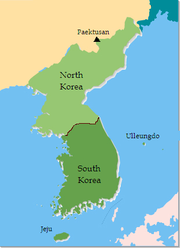

This is a list of mammals found in the wild on the Korean Peninsula
Korean Peninsula
The Korean Peninsula is a peninsula in East Asia. It extends southwards for about 684 miles from continental Asia into the Pacific Ocean and is surrounded by the Sea of Japan to the south, and the Yellow Sea to the west, the Korea Strait connecting the first two bodies of water.Until the end of...
. Approximately 100 species of mammals are known to inhabit, or recently to have inhabited, the peninsula and its surrounding waters. This includes a few species, such as the Nutria and Muskrat
Muskrat
The muskrat , the only species in genus Ondatra, is a medium-sized semi-aquatic rodent native to North America, and introduced in parts of Europe, Asia, and South America. The muskrat is found in wetlands and is a very successful animal over a wide range of climates and habitats...
, that were introduced in the 20th century. It also includes other species listed here, such as the Amur Tiger
Amur Tiger
The Siberian tiger , also known as the Amur tiger, is a tiger subspecies inhabiting mainly the Sikhote Alin mountain region with a small subpopulation in southwest Primorye province in the Russian Far East. In 2005, there were 331–393 adult-subadult Amur tigers in this region, with a breeding adult...
and Japanese Sea Lion
Japanese Sea Lion
The Japanese Sea Lion is thought to have become extinct in the 1970s. Prior to 2003 it was considered to be a subspecies of California Sea Lion as Zalophus californianus japonicus. However, it was subsequently reclassified as a separate species. Some taxonomists still consider it as a subspecies...
, which have probably been extirpated but are still included in standard lists of Korean mammals.
Most of these species are found only in a small part of Korea. The large southeastern island of Jeju
Jeju-do
Jeju-do is the only special autonomous province of South Korea, situated on and coterminous with the country's largest island. Jeju-do lies in the Korea Strait, southwest of Jeollanam-do Province, of which it was a part before it became a separate province in 1946...
, and the rugged northeastern Paektusan region, are particularly known for their distinctive fauna. Several species, including the Dsinezumi Shrew
Dsinezumi Shrew
The Dsinezumi Shrew , also known as the Japanese White-toothed Shrew, is a species of musk shrew found in Japan and on Korea's Jeju Island. It is widespread, and considered to be of "least concern" by the IUCN....
, are found only on Jeju, while many other species such as the Wild Boar are absent or extirpated from there.
The species included in this list are drawn from Won and Smith (1999). Information on the international status of species has been drawn from the IUCN Red List
IUCN Red List
The IUCN Red List of Threatened Species , founded in 1963, is the world's most comprehensive inventory of the global conservation status of biological species. The International Union for Conservation of Nature is the world's main authority on the conservation status of species...
.
Order Artiodactyla: Even-toed Ungulates
| Common name (Korean name) |
Species (Authority) |
Preferred habitat | Range | Status |
|---|---|---|---|---|
| Family Bovidae: Bovids | ||||
| Long-tailed Goral Long-tailed Goral The long-tailed goral is a species of wild goat found in the mountains of eastern and northern Asia, including Russia, China, and Korea. A population of this species exists in the Korean Demilitarized Zone, near the tracks of the Donghae Bukbu Line. The species is classified as endangered in South... |
Naemorhedus caudatus (Hamilton Smith Charles Hamilton Smith Lieutenant-Colonel Charles Hamilton Smith was an English artist, naturalist, antiquary, illustrator, soldier and spy.-Military service:... , 1827) |
High mountains. | Northern Taebaek Mountains Taebaek Mountains The Taebaek Mountains are a mountain range in both North Korea and South Korea. They form the main ridge of the Korean peninsula.-Geography:... , including the Demilitarized Zone Korean Demilitarized Zone The Korean Demilitarized Zone is a strip of land running across the Korean Peninsula that serves as a buffer zone between North and South Korea. The DMZ cuts the Korean Peninsula roughly in half, crossing the 38th parallel on an angle, with the west end of the DMZ lying south of the parallel and... . |
|
| Family Cervidae: Deer | ||||
| Siberian Roe Deer Siberian Roe Deer Capreolus pygargus, also known as the Siberian roe deer or eastern roe deer, is a species of roe deer found in northeastern Asia. In addition to Siberia and Mongolia, it is found in Kazakhstan, the Tian Shan Mountains, Eastern Tibet, the Korean peninsula, and northeastern China... |
Capreolus pygargus (Pallas Peter Simon Pallas Peter Simon Pallas was a German zoologist and botanist who worked in Russia.- Life and work :Pallas was born in Berlin, the son of Professor of Surgery Simon Pallas. He studied with private tutors and took an interest in natural history, later attending the University of Halle and the University... , 1771) |
Forest verges. | Throughout; not found on Ulleungdo Ulleungdo Ulleungdo is a South Korean island in the Sea of Japan . Formerly known as Dagelet to the Europeans, Ulleungdo is about 120 km east of the Korean Peninsula... . |
|
| Wapiti Elk The Elk is the large deer, also called Cervus canadensis or wapiti, of North America and eastern Asia.Elk may also refer to:Other antlered mammals:...  |
Cervus canadensis (Erxleben Johann Christian Polycarp Erxleben Johann Christian Polycarp Erxleben was a German naturalist from Quedlinburg.Erxleben was Professor of physics and veterinary medicine at the University of Göttingen. He wrote Anfangsgründe der Naturlehre and Systema regni animalis... , 1777) |
Forest verges. | North Hamgyong and the Paektusan region. |
|
|- valign="top"
|Sika Deer
Sika Deer
The Sika Deer, Cervus nippon, also known as the Spotted Deer or the Japanese Deer, is a species of deer native to much of East Asia and introduced to various other parts of the world...

|Cervus nippon
(Temminck
Coenraad Jacob Temminck
Coenraad Jacob Temminck was a Dutch aristocrat and zoologist.Temminck was the first director of the National Natural History Museum at Leiden from 1820 until his death. His Manuel d'ornithologie, ou Tableau systematique des oiseaux qui se trouvent en Europe was the standard work on European birds...
, 1838)
|Open forests and forest verges.
|Throughout mainland.
|
- I: Least ConcernLeast ConcernLeast Concern is an IUCN category assigned to extant taxon or lower taxa which have been evaluated but do not qualify for any other category. As such they do not qualify as threatened, Near Threatened, or Conservation Dependent...
. - K: VulnerableVulnerable speciesOn 30 January 2010, the IUCN Red List of Threatened Species identified 9694 Vulnerable species, subspecies and varieties, stocks and sub-populations.-References:...
. - NK: Natural monumentNatural monuments of North KoreaThis is a partial list of the natural monuments of North Korea. A total of 935 natural monuments have been designated.-No. 1 - 50:-50-100:-No. 101 - 150:-No. 251 - 300:-No. 351 - 400:-See also:*Natural monuments of South Korea...
.
|-valign="top"
|Water Deer
Water Deer
The Water Deer is a small deer superficially more similar to a musk deer than a true deer but it is classified as a cervid despite having tusks instead of antlers and other anatomical anomalies. These unique characteristics have caused it to be classified in its own genus...

|Hydropotes inermis
(Swinhoe
Robert Swinhoe
Robert Swinhoe FRS , was an English naturalist who worked as a Consul in Formosa. He discovered many Southeast Asian birds and several, such as Swinhoe's Pheasant, are named after him.-Biography:...
, 1870)
|Low mountains and riparian areas.
|Throughout mainland.
|
- I: Near ThreatenedNear ThreatenedNear Threatened is a conservation status assigned to species or lower taxa that may be considered threatened with extinction in the near future, although it does not currently qualify for the threatened status...
. - SK: GameGame (food)Game is any animal hunted for food or not normally domesticated. Game animals are also hunted for sport.The type and range of animals hunted for food varies in different parts of the world. This will be influenced by climate, animal diversity, local taste and locally accepted view about what can or...
.
|-
| style="text-align:center;" colspan=5| Family Suidae
Suidae
Suidae is the biological family to which pigs belong. In addition to numerous fossil species, up to sixteen extant species are currently recognized, classified into between four and eight genera...
: Pigs
|- valign="top"
|Wild Boar

|Sus scrofa
(Linnaeus, 1758)
|Mountain forests.
|Throughout mainland.
|
- I: Least ConcernLeast ConcernLeast Concern is an IUCN category assigned to extant taxon or lower taxa which have been evaluated but do not qualify for any other category. As such they do not qualify as threatened, Near Threatened, or Conservation Dependent...
- SK: GameGame (food)Game is any animal hunted for food or not normally domesticated. Game animals are also hunted for sport.The type and range of animals hunted for food varies in different parts of the world. This will be influenced by climate, animal diversity, local taste and locally accepted view about what can or...
|-
| style="text-align:center;" colspan=5| Family Moschidae: Musk deer
|- valign="top"
|Siberian Musk Deer
Siberian musk deer
The Siberian musk deer is a musk deer found in the mountain forests of Northeast Asia. Its is most common in the taiga of southern Siberia, but is also found in parts of Mongolia, Inner Mongolia, Manchuria and the Korean peninsula. It is largely nocturnal, and migrates only over short distances. ...

|Moschus moschiferus
(Linnaeus, 1758)
|Mountain forests.
|North Korea; also found in Gangwon, South Korea.
|
- I: VulnerableVulnerable speciesOn 30 January 2010, the IUCN Red List of Threatened Species identified 9694 Vulnerable species, subspecies and varieties, stocks and sub-populations.-References:...
. - K: Endangered.
- NK: Natural monumentNatural monuments of North KoreaThis is a partial list of the natural monuments of North Korea. A total of 935 natural monuments have been designated.-No. 1 - 50:-50-100:-No. 101 - 150:-No. 251 - 300:-No. 351 - 400:-See also:*Natural monuments of South Korea...
. - SK: Natural monumentNatural monuments of South KoreaThis is a partial list of natural monuments of South Korea. By 2009 a total of 576 animal, plants, landforms, geological formations, and nature reserves had been designated by the Cultural Heritage Administration of South Korea as natural monuments...
.
|}
Order Carnivora: Carnivores
| Common name (Korean name) |
Species (Authority) |
Preferred habitat | Range | Status |
|---|---|---|---|---|
| Family Canidae Canidae Canidae is the biological family of carnivorous and omnivorous mammals that includes wolves, foxes, jackals, coyotes, and domestic dogs. A member of this family is called a canid . The Canidae family is divided into two tribes: Canini and Vulpini... : Canids |
||||
| eurasian Wolf Eurasian Wolf The Eurasian Wolf , also known as the, European, Common or Forest Wolf is a subspecies of grey wolf which has the largest range among wolf subspecies and is the most common in Europe and Asia, ranging through Mongolia, China, Russia, Scandinavia, Western Europe and the Himalayan Mountains... 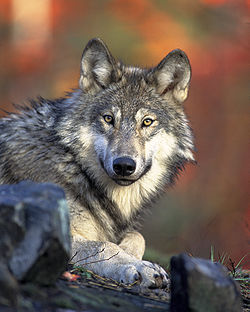 |
Canis lupus (Linnaeus, 1758) |
Forests and open woods. | Paektusan area. |
|
| Dhole Dhole The dhole is a species of canid native to South and Southeast Asia. It is the only extant member of the genus Cuon, which differs from Canis by the reduced number of molars and greater number of teats...  |
Cuon alpinus (Pallas Peter Simon Pallas Peter Simon Pallas was a German zoologist and botanist who worked in Russia.- Life and work :Pallas was born in Berlin, the son of Professor of Surgery Simon Pallas. He studied with private tutors and took an interest in natural history, later attending the University of Halle and the University... , 1811) |
Dense forests and high mountains. | Paektusan area. |
|
| Raccoon Dog Raccoon Dog The raccoon dog , also known as the magnut or tanuki, is a canid indigenous to east Asia. It is the only extant species in the genus Nyctereutes... 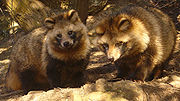 |
Nyctereutes procyonoides (Gray John Edward Gray John Edward Gray, FRS was a British zoologist. He was the elder brother of George Robert Gray and son of the pharmacologist and botanist Samuel Frederick Gray .... , 1834) |
Wooded valleys. | Throughout mainland. |
|
| Fox Fox Fox is a common name for many species of omnivorous mammals belonging to the Canidae family. Foxes are small to medium-sized canids , characterized by possessing a long narrow snout, and a bushy tail .Members of about 37 species are referred to as foxes, of which only 12 species actually belong to...  |
Vulpes vulpes (Linnaeus, 1758) |
Brushy areas and forest verges. | Northern and northeastern Korea. |
|
| Family Felidae Felidae Felidae is the biological family of the cats; a member of this family is called a felid. Felids are the strictest carnivores of the thirteen terrestrial families in the order Carnivora, although the three families of marine mammals comprising the superfamily pinnipedia are as carnivorous as the... : Felids |
||||
| Leopard Cat Leopard Cat The leopard cat is a small wild cat of South and East Asia. Since 2002 it has been listed as Least Concern by IUCN as it is widely distributed but threatened by habitat loss and hunting in parts of its range... 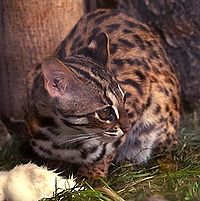 |
Prionailurus bengalensis (Kerr Robert Kerr (writer) Robert Kerr FRS was a scientific writer and translator from Scotland.Kerr was born in Roxburghshire as the son of a jeweller. He studied medicine at the University of Edinburgh and practised at the Edinburgh Foundling Hospital as a surgeon... , 1792) |
Dense forests. | Central and northern Korea. |
|
| Eurasian Lynx Eurasian Lynx The Eurasian lynx is a medium-sized cat native to European and Siberian forests, South Asia and East Asia. It is also known as the European lynx, common lynx, the northern lynx, and the Siberian or Russian lynx...  |
Lynx lynx (Linnaeus, 1758) |
Montane forests. | North Hamgyong and Chagang, North Korea. |
|
| Amur Leopard Amur Leopard The Amur leopard , also known as the Far Eastern leopard, Korean leopard, and Manchurian leopard is one of nine recognised subspecies of leopard. It is a wild feline predator native to the mountainous areas of the Russian Far East. It used to inhabit the forests of Korea and China, but it has... |
Panthera pardus orientalis (Schlegel Schlegel Schlegel is a name of German origin, related to Schlägel "sledgehammer, mallet". It may refer to:-Places:*Schlegel, Saxony, a village in the district of Löbau-Zittau in Saxony belonging to the town of Zittau... , 1857) |
High dense forests. | Northern Korea. |
|
| Amur Tiger Amur Tiger The Siberian tiger , also known as the Amur tiger, is a tiger subspecies inhabiting mainly the Sikhote Alin mountain region with a small subpopulation in southwest Primorye province in the Russian Far East. In 2005, there were 331–393 adult-subadult Amur tigers in this region, with a breeding adult... 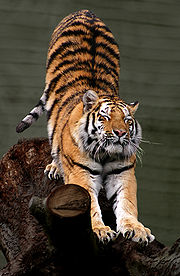 |
Panthera tigris altaica (Temminck, 1844) |
Rocky forests. | Hamgyong Hamgyong Hamgyŏng was one of the Eight Provinces of Korea during the Joseon Dynasty. Hamgyŏng was located in the northeast of Korea. The provincial capital was Hamhŭng.-History:... provinces, northeastern North Korea. |
|
| Family Mustelidae Mustelidae Mustelidae , commonly referred to as the weasel family, are a family of carnivorous mammals. Mustelids are diverse and the largest family in the order Carnivora, at least partly because in the past it has been a catch-all category for many early or poorly differentiated taxa... : Mustelids |
||||
| European Otter European Otter The European Otter , also known as the Eurasian otter, Eurasian river otter, common otter and Old World otter, is a European and Asian member of the Lutrinae or otter subfamily, and is typical of freshwater otters.... 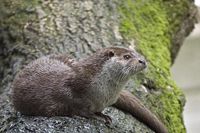 |
Lutra lutra (Linnaeus Carolus Linnaeus Carl Linnaeus , also known after his ennoblement as , was a Swedish botanist, physician, and zoologist, who laid the foundations for the modern scheme of binomial nomenclature. He is known as the father of modern taxonomy, and is also considered one of the fathers of modern ecology... , 1758) |
Riparian areas. | Throughout mainland, scattered. |
|
| Yellow-throated Marten
|
Martes flavigula (Boddaert Pieter Boddaert Pieter Boddaert was a Dutch physician and naturalist.Boddaert was the son of a Middelburg jurist and poet by the same name . Pieter Jr. obtained his M.D. at the University of Utrecht in 1764 and there became a lecturer on natural history. Fourteen letters survive of his correspondence with Carl... , 1785) |
High forests. | Northern Korea. |
|
| Japanese Marten
|
Martes melampus (Wagner Johann Andreas Wagner Johann Andreas Wagner was a German palaeontologist, zoologist and archaeologist.Wagner was a professor at the University of Munich, and curator of the Zoologische Staatssammlung .... , 1841) |
High forests. | Central and northern Korea. |
|
| Sable Sable The sable is a species of marten which inhabits forest environments, primarily in Russia from the Ural Mountains throughout Siberia, in northern Mongolia and China and on Hokkaidō in Japan. Its range in the wild originally extended through European Russia to Poland and Scandinavia... .png) |
Martes zibellina (Linnaeus Carolus Linnaeus Carl Linnaeus , also known after his ennoblement as , was a Swedish botanist, physician, and zoologist, who laid the foundations for the modern scheme of binomial nomenclature. He is known as the father of modern taxonomy, and is also considered one of the fathers of modern ecology... , 1758) |
High, dense boreal forests. | North Hamgyong, northeastern North Korea. |
|
| Asian Badger Asian Badger The Asian badger , also known as the sand badger is a species of badger native to China, Kazakhstan, the Korean Peninsula and Russia.-Description:... |
Meles leucurus (Hodgson, 1847) |
Forests and mountain valleys. Fossorial Fossorial A fossorial organism is one that is adapted to digging and life underground such as the badger, the naked mole rat, and the mole salamanders Ambystomatidae... . |
Throughout mainland. |
|
| Least Weasel Least Weasel The least weasel is the smallest member of the Mustelidae , native to Eurasia, North America and North Africa, though it has been introduced elsewhere. It is classed as Least Concern by the IUCN, due to its wide distribution and presumably large population... .jpg) |
Mustela nivalis (Linnaeus Carolus Linnaeus Carl Linnaeus , also known after his ennoblement as , was a Swedish botanist, physician, and zoologist, who laid the foundations for the modern scheme of binomial nomenclature. He is known as the father of modern taxonomy, and is also considered one of the fathers of modern ecology... , 1758) |
Subalpine Subalpine The subalpine zone is the biotic zone immediately below tree line around the world. Species that occur in this zone depend on the location of the zone on the Earth, for example, Snow Gum in Australia, or Subalpine Larch, Mountain Hemlock and Subalpine Fir in western North America.Trees in the... areas. |
Far northeastern and northwestern North Korea North Korea The Democratic People’s Republic of Korea , , is a country in East Asia, occupying the northern half of the Korean Peninsula. Its capital and largest city is Pyongyang. The Korean Demilitarized Zone serves as the buffer zone between North Korea and South Korea... . |
|
| Siberian Weasel Siberian Weasel The Siberian weasel , also known as the Kolonok, is a medium-sized species of weasel native to Asia. It is classed as Least Concern for extinction by the IUCN, due to its wide distribution and presumably large numbers....  |
Mustela sibirica (Pallas Peter Simon Pallas Peter Simon Pallas was a German zoologist and botanist who worked in Russia.- Life and work :Pallas was born in Berlin, the son of Professor of Surgery Simon Pallas. He studied with private tutors and took an interest in natural history, later attending the University of Halle and the University... , 1773) |
Forests and riparian areas. | Throughout, including Jeju Jeju-do Jeju-do is the only special autonomous province of South Korea, situated on and coterminous with the country's largest island. Jeju-do lies in the Korea Strait, southwest of Jeollanam-do Province, of which it was a part before it became a separate province in 1946... . |
|
| Family Ursidae: Bears | ||||
| Asiatic Black Bear Asiatic Black Bear The Asian black bear , also known as the moon bear or white-chested bear is a medium-sized species of bear, largely adapted for arboreal life, which occurs through much of southern Asia, Korea, northeastern China, the Russian far east and Honshū and Shikoku islands of Japan...  |
Ursus thibetanus (G. Cuvier Georges Cuvier Georges Chrétien Léopold Dagobert Cuvier or Jean Léopold Nicolas Frédéric Cuvier , known as Georges Cuvier, was a French naturalist and zoologist... , 1823) |
Thick forests. | Jirisan Jirisan Jirisan is a mountain in the southern region of South Korea. It is often considered one of the three most important mountains in South Korea , with Hallasan and Seoraksan being the other two.... and Seoraksan Seoraksan Seoraksan is the highest mountain in the Taebaek mountain range in the Gangwon province in eastern South Korea. It is located in a national park near the city of Sokcho. After the Hallasan volcano on Jeju Island and Jirisan in the south, Seoraksan is the third highest mountain in South Korea. The... in South Korea; Kumgangsan Kumgangsan Kŭmgangsan , Geumgangsan, or Mount Geumgang is a -high mountain in Kangwon-do, North Korea. Its name means "a firm heart in the face of truth". It is about 50 km away from South Korea's Sokcho in Gangwon-do. It is one of the best-known mountains in North Korea... and Paektusan in North Korea. |
|
| Brown Bear Brown Bear The brown bear is a large bear distributed across much of northern Eurasia and North America. It can weigh from and its largest subspecies, the Kodiak Bear, rivals the polar bear as the largest member of the bear family and as the largest land-based predator.There are several recognized...  |
Ursus arctos (Linnaeus, 1758) |
Thick forests. | Central and northern Korea. |
|
| Superfamily Pinniped Pinniped Pinnipeds or fin-footed mammals are a widely distributed and diverse group of semiaquatic marine mammals comprising the families Odobenidae , Otariidae , and Phocidae .-Overview: Pinnipeds are typically sleek-bodied and barrel-shaped... ia: Pinnipeds |
||||
| Common name | Species
(Authority) |
Preferred habitat | Range | Status |
| Family Otariidae: Eared Seals | ||||
| Northern Fur Seal Northern Fur Seal The Northern fur seal is an eared seal found along the north Pacific Ocean, the Bering Sea and the Sea of Okhotsk. It is the largest member of the fur seal subfamily and the only species in the genus Callorhinus.-Physical description:Northern fur seals have extreme sexual dimorphism, with males... 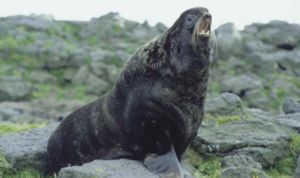 |
Callorhinus ursinus (Linnaeus, 1758) |
Coasts and seas. | Most common in the Sea of Japan Sea of Japan The Sea of Japan is a marginal sea of the western Pacific Ocean, between the Asian mainland, the Japanese archipelago and Sakhalin. It is bordered by Japan, North Korea, Russia and South Korea. Like the Mediterranean Sea, it has almost no tides due to its nearly complete enclosure from the Pacific... . |
|
| Steller's Sea Lion Steller's Sea Lion The Steller sea lion also known as the northern sea lion, is a threatened species of sea lion in the northern Pacific. It is the sole member of the genus Eumetopias and the largest of the eared seals . Among pinnipeds, it is inferior in size only to the walrus and the two elephant seals... 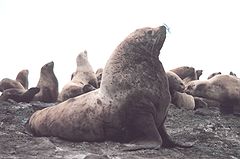 |
Eumetopias jubatus (Schreber Johann Christian Daniel von Schreber Johann Christian Daniel von Schreber , often styled I.C.D. von Schreber, was a German naturalist.-Career:He was elected Professor of Materia medica at the University of Erlangen in 1769.... , 1776) |
Coasts and seas. | Northern Yellow Sea Yellow Sea The Yellow Sea is the name given to the northern part of the East China Sea, which is a marginal sea of the Pacific Ocean. It is located between mainland China and the Korean Peninsula. Its name comes from the sand particles from Gobi Desert sand storms that turn the surface of the water golden... and Sea of Japan Sea of Japan The Sea of Japan is a marginal sea of the western Pacific Ocean, between the Asian mainland, the Japanese archipelago and Sakhalin. It is bordered by Japan, North Korea, Russia and South Korea. Like the Mediterranean Sea, it has almost no tides due to its nearly complete enclosure from the Pacific... |
|
| California Sea Lion California Sea Lion The California sea lion is a coastal sea lion of western North America. Their numbers are abundant , and the population continues to expand about 5% annually. They are quite intelligent and can adapt to man-made environments... |
Zalophus japonicus (Peters, 1866) |
Rocky coasts. | Last seen on Liancourt Rocks Liancourt Rocks The Liancourt Rocks, also known as Dokdo or Tokto in Korean or in Japanese, are a group of small islets in the Sea of Japan . Sovereignty over the islets is disputed between Japan and South Korea... in 1951. |
|
| Family Phocidae: Earless Seals | ||||
Common Seal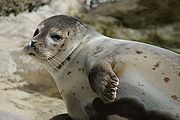 |
Phoca vitulina (Linnaeus, 1758) |
Coasts and seas. | Northern Sea of Japan Sea of Japan The Sea of Japan is a marginal sea of the western Pacific Ocean, between the Asian mainland, the Japanese archipelago and Sakhalin. It is bordered by Japan, North Korea, Russia and South Korea. Like the Mediterranean Sea, it has almost no tides due to its nearly complete enclosure from the Pacific... . |
|
| Spotted Seal Spotted Seal The spotted seal , also known as the larga or largha seal, is a member of the family Phocidae, and is considered a "true seal". It inhabits ice floes and waters of the north Pacific Ocean and adjacent seas...  |
Phoca largha (Pallas, 1811) |
Coasts and seas. | Throughout Yellow Sea Yellow Sea The Yellow Sea is the name given to the northern part of the East China Sea, which is a marginal sea of the Pacific Ocean. It is located between mainland China and the Korean Peninsula. Its name comes from the sand particles from Gobi Desert sand storms that turn the surface of the water golden... , Sea of Japan Sea of Japan The Sea of Japan is a marginal sea of the western Pacific Ocean, between the Asian mainland, the Japanese archipelago and Sakhalin. It is bordered by Japan, North Korea, Russia and South Korea. Like the Mediterranean Sea, it has almost no tides due to its nearly complete enclosure from the Pacific... , and Korea Strait Korea Strait The Korea Strait is a sea passage between South Korea and Japan, connecting the East China Sea and the Sea of Japan in the northwest Pacific Ocean... ; large colony on Baengnyeongdo. |
|
Order Cetacea: Whales
| Common name (Korean name) |
Species (Authority) |
Preferred habitat | Range | Status |
|---|---|---|---|---|
| Suborder Mysticeti: Baleen whales | ||||
| Family Balaenopteridae: Rorquals | ||||
| Minke Whale Minke Whale Minke whale , or lesser rorqual, is a name given to two species of marine mammal belonging to a clade within the suborder of baleen whales. The minke whale was given its official designation by Lacepède in 1804, who described a dwarf form of Balænoptera acuto-rostrata...  |
Balaenoptera acutorostrata (Lacépède, 1804) |
Widespread. | Yellow Sea Yellow Sea The Yellow Sea is the name given to the northern part of the East China Sea, which is a marginal sea of the Pacific Ocean. It is located between mainland China and the Korean Peninsula. Its name comes from the sand particles from Gobi Desert sand storms that turn the surface of the water golden... , East China Sea East China Sea The East China Sea is a marginal sea east of China. It is a part of the Pacific Ocean and covers an area of 1,249,000 km² or 750,000 square miles.-Geography:... , Sea of Japan Sea of Japan The Sea of Japan is a marginal sea of the western Pacific Ocean, between the Asian mainland, the Japanese archipelago and Sakhalin. It is bordered by Japan, North Korea, Russia and South Korea. Like the Mediterranean Sea, it has almost no tides due to its nearly complete enclosure from the Pacific... . |
|
| Blue Whale Blue Whale The blue whale is a marine mammal belonging to the suborder of baleen whales . At in length and or more in weight, it is the largest known animal to have ever existed.... 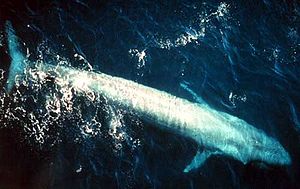 |
Balaenoptera musculus (Linnaeus, 1758) |
Deep ocean waters. |
|
|
| Fin Whale Fin Whale The fin whale , also called the finback whale, razorback, or common rorqual, is a marine mammal belonging to the suborder of baleen whales. It is the second longest whale and the sixth largest living animal after the blue whale, bowhead whale, and right whales, growing to nearly 27 metres long...  |
Balaenoptera physalus (Linnaeus, 1758) |
Coastal waters. | Sea of Japan Sea of Japan The Sea of Japan is a marginal sea of the western Pacific Ocean, between the Asian mainland, the Japanese archipelago and Sakhalin. It is bordered by Japan, North Korea, Russia and South Korea. Like the Mediterranean Sea, it has almost no tides due to its nearly complete enclosure from the Pacific... and Yellow Sea Yellow Sea The Yellow Sea is the name given to the northern part of the East China Sea, which is a marginal sea of the Pacific Ocean. It is located between mainland China and the Korean Peninsula. Its name comes from the sand particles from Gobi Desert sand storms that turn the surface of the water golden... . |
|
| Family Eschrichtiidae: Gray Whales | ||||
| Gray Whale Gray Whale The gray whale, Eschrichtius robustus, is a baleen whale that migrates between feeding and breeding grounds yearly. It reaches a length of about , a weight of , and lives 50–70 years. The common name of the whale comes from the gray patches and white mottling on its dark skin. Gray whales were... 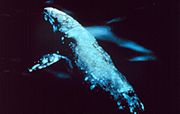 |
Eschrichtius robustus (Lilljeborg Wilhelm Lilljeborg Wilhelm Lilljeborg was a Swedish zoologist. He is particularly known for his work on the Cladocera of Sweden, and on the Balaenoptera. Lilljeborg was a member of the Royal Swedish Academy of Sciences from 1861.-References:... , 1861) |
Migratory through coastal waters. | Sea of Japan Sea of Japan The Sea of Japan is a marginal sea of the western Pacific Ocean, between the Asian mainland, the Japanese archipelago and Sakhalin. It is bordered by Japan, North Korea, Russia and South Korea. Like the Mediterranean Sea, it has almost no tides due to its nearly complete enclosure from the Pacific... , Korea Strait Korea Strait The Korea Strait is a sea passage between South Korea and Japan, connecting the East China Sea and the Sea of Japan in the northwest Pacific Ocean... . |
|
| Suborder Odontoceti: Toothed Whales | ||||
| Family Delphinidae: Oceanic dolphins | ||||
| Short-Beaked Common Dolphin Short-beaked Common Dolphin The short-beaked common dolphin is a species of common dolphin. It has a larger range than the long-beaked common dolphin , occurring throughout warm-temperate and tropical oceans, with the possible exception of the Indian Ocean... 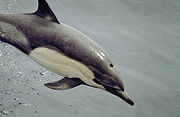 |
Delphinus delphis (Linnaeus, 1758) |
Warmer coastal waters. | Throughout. |
|
| Pacific White-Sided Dolphin Pacific White-sided Dolphin The Pacific White-sided Dolphin is a very active dolphin found in the cool to temperate waters of the North Pacific Ocean.-Taxonomy:... 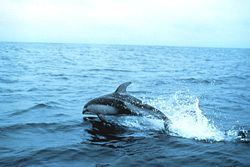 |
Lagenorhynchus obliquidens (Gill Theodore Gill Theodore Nicholas Gill was an American ichthyologist, mammalogist, malacologist and librarian.Born and educated in New York City under private tutors, Gill early showed interest in natural history. He was associated with J... , 1865) |
Warmer coastal waters. | Sea of Japan Sea of Japan The Sea of Japan is a marginal sea of the western Pacific Ocean, between the Asian mainland, the Japanese archipelago and Sakhalin. It is bordered by Japan, North Korea, Russia and South Korea. Like the Mediterranean Sea, it has almost no tides due to its nearly complete enclosure from the Pacific... |
|
| Orca Orca The killer whale , commonly referred to as the orca, and less commonly as the blackfish, is a toothed whale belonging to the oceanic dolphin family. Killer whales are found in all oceans, from the frigid Arctic and Antarctic regions to tropical seas... 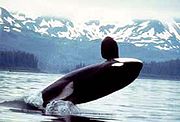 |
Orcinus orca (Linnaeus, 1758) |
Coastal waters. | Throughout. |
|
| Family Phocoenidae: Porpoises | ||||
| Dall's Porpoise Dall's Porpoise Dall's porpoise is a species of porpoise found on the North Pacific. It came to worldwide attention in the 1970s when it was disclosed for the first time to the public that salmon fishing trawls were killing a lot, thousands of Dall's porpoises and other cetaceans each year by accidentally...  |
Phocoenoides dalli (True Frederick W. True Frederick William True was an American biologist, the first head curator of biology at the United States National Museum, now part of the Smithsonian Institution.... , 1885) |
Colder ocean waters. | North of the 35th parallel in the Sea of Japan Sea of Japan The Sea of Japan is a marginal sea of the western Pacific Ocean, between the Asian mainland, the Japanese archipelago and Sakhalin. It is bordered by Japan, North Korea, Russia and South Korea. Like the Mediterranean Sea, it has almost no tides due to its nearly complete enclosure from the Pacific... . |
|
Harbor Porpoise
 |
Phocoena phocoena (Linnaeus, 1758) |
Colder ocean waters. | Sea of Japan Sea of Japan The Sea of Japan is a marginal sea of the western Pacific Ocean, between the Asian mainland, the Japanese archipelago and Sakhalin. It is bordered by Japan, North Korea, Russia and South Korea. Like the Mediterranean Sea, it has almost no tides due to its nearly complete enclosure from the Pacific... . |
|
| Finless Porpoise Finless Porpoise The finless porpoise is one of six porpoise species. In the waters around Japan, at the northern end of its range, it is known as the sunameri . A freshwater population found in the Yangtze River in China is known locally as the jiangzhu or "river pig". There is a degree of taxonomic uncertainty... |
Neophocaena phocaenoides (Cuvier Georges Cuvier Georges Chrétien Léopold Dagobert Cuvier or Jean Léopold Nicolas Frédéric Cuvier , known as Georges Cuvier, was a French naturalist and zoologist... , 1829) |
Coastal waters. | Yellow Sea Yellow Sea The Yellow Sea is the name given to the northern part of the East China Sea, which is a marginal sea of the Pacific Ocean. It is located between mainland China and the Korean Peninsula. Its name comes from the sand particles from Gobi Desert sand storms that turn the surface of the water golden... , Korea Strait Korea Strait The Korea Strait is a sea passage between South Korea and Japan, connecting the East China Sea and the Sea of Japan in the northwest Pacific Ocean... , southern Sea of Japan Sea of Japan The Sea of Japan is a marginal sea of the western Pacific Ocean, between the Asian mainland, the Japanese archipelago and Sakhalin. It is bordered by Japan, North Korea, Russia and South Korea. Like the Mediterranean Sea, it has almost no tides due to its nearly complete enclosure from the Pacific... . |
|
| Family Physeteridae: Sperm whales | ||||
| Sperm Whale Sperm Whale The sperm whale, Physeter macrocephalus, is a marine mammal species, order Cetacea, a toothed whale having the largest brain of any animal. The name comes from the milky-white waxy substance, spermaceti, found in the animal's head. The sperm whale is the only living member of genus Physeter... 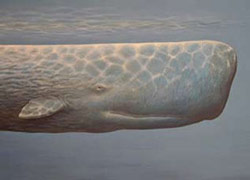 |
Physeter macrocephalus (Linnaeus, 1758) |
Deep oceans. | East China Sea East China Sea The East China Sea is a marginal sea east of China. It is a part of the Pacific Ocean and covers an area of 1,249,000 km² or 750,000 square miles.-Geography:... |
|
| Family Ziphiidae: Beaked whales | ||||
Baird's Beaked Whale
 |
Berardius bairdii (Stejneger, 1883) |
Open seas. | Sea of Japan Sea of Japan The Sea of Japan is a marginal sea of the western Pacific Ocean, between the Asian mainland, the Japanese archipelago and Sakhalin. It is bordered by Japan, North Korea, Russia and South Korea. Like the Mediterranean Sea, it has almost no tides due to its nearly complete enclosure from the Pacific... . |
|
Order Erinaceomorpha: Hedgehogs
| Common name (Korean name) |
Species (Authority) |
Preferred habitat | Range | Status |
|---|---|---|---|---|
| Family Erinaceidae Erinaceidae Erinaceidae is the only living family in the order Erinaceomorpha, which has recently been subsumed with Soricomorpha into the order Eulipotyphla... : Hedgehogs |
||||
| Amur Hedgehog Amur Hedgehog The Amur Hedgehog is a hedgehog similar to the West European Hedgehog in outlook and lifestyle, although it is more lightly coloured. An average animal weighs from 600 to 1000 grams. Native to Amur Krai and Primorye in Russia, Manchuria in China and the Korean peninsula.... 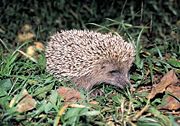 |
Erinaceus amurensis (Schrenk, 1859) |
Deciduous and mixed forests. | Throughout mainland. |
|
Order Soricomorpha: Shrews and moles
| Common name (Korean name) |
Species (Authority) |
Preferred habitat | Range | Status |
|---|---|---|---|---|
| Family Talpidae Talpidae The family Talpidae includes the moles, shrew moles, desmans, and other intermediate forms of small insectivorous mammals of the order Soricomorpha... : Moles |
||||
| Japanese Mole Japanese Mole The Japanese Mole , also known as Temminck's Mole, is a species of mole native to East Asia. Its range extends south from the Ussuri River and the Amur River through Manchuria, Korea, and Japan. A solitary and diurnal species, it can live for up to 3.5 years in the wild.-External links:**... |
Mogera wogura (Temminck, 1833) |
High moist forest. | Throughout mainland; not found on Jeju Jeju-do Jeju-do is the only special autonomous province of South Korea, situated on and coterminous with the country's largest island. Jeju-do lies in the Korea Strait, southwest of Jeollanam-do Province, of which it was a part before it became a separate province in 1946... or Ulleungdo Ulleungdo Ulleungdo is a South Korean island in the Sea of Japan . Formerly known as Dagelet to the Europeans, Ulleungdo is about 120 km east of the Korean Peninsula... |
|
| Family Soricidae: Shrews | ||||
| Dsinezumi Shrew Dsinezumi Shrew The Dsinezumi Shrew , also known as the Japanese White-toothed Shrew, is a species of musk shrew found in Japan and on Korea's Jeju Island. It is widespread, and considered to be of "least concern" by the IUCN.... |
Crocidura dsinezumi (Temminck, 1842) |
Damp forests and grasslands. | Found only on Jeju Jeju-do Jeju-do is the only special autonomous province of South Korea, situated on and coterminous with the country's largest island. Jeju-do lies in the Korea Strait, southwest of Jeollanam-do Province, of which it was a part before it became a separate province in 1946... . |
|
| Ussuri Shrew
|
Crocidura lasiura (Dobson, 1890) |
Widespread. | Throughout mainland. |
|
Lesser Shrew
 |
Crocidura suaveolens (Pallas, 1811) |
Moist deciduous forests. | Throughout, including Ulleungdo Ulleungdo Ulleungdo is a South Korean island in the Sea of Japan . Formerly known as Dagelet to the Europeans, Ulleungdo is about 120 km east of the Korean Peninsula... . |
|
| Eurasian Water Shrew Eurasian Water Shrew The Eurasian Water Shrew, Neomys fodiens, known in the United Kingdom as the Water Shrew, is a relatively large shrew, up to long, with a tail up to three-quarters as long again. It has short dark fur, often with a few white tufts, a white belly, and a few stiff hairs around the feet and tail... 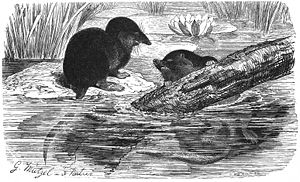 |
Neomys fodiens (Pennant, 1771) |
Riparian areas and mountain lakes. | Northern North Korea. |
|
| Laxmann's Shrew Laxmann's Shrew Laxmann's Shrew is a species of shrew. An adult Laxmann's Shrew has a weight of 3-11 grams and a body length of 4.8-7.8 cm, with a tail of 3.9-5.2 cm. It is reported across northern Eurasia from the Baltic to the Sea of Japan, including Hokkaidō, Sakhalin, and the Korean Peninsula... |
Sorex caecutiens (Laxmann, 1788) |
Rugged mountains. | Northern and northeastern North Korea. |
|
| Large-Toothed Siberian Shrew
|
Sorex daphaenodon (Thomas Oldfield Thomas Oldfield Thomas FRS was a British zoologist.Thomas worked at the Natural History Museum on mammals, describing about 2,000 new species and sub-species for the first time. He was appointed to the Museum Secretary's office in 1876, transferring to the Zoological Department in 1878... , 1907) |
Boreal forests and alpine meadows. | Paektusan region. |
|
| Slender Shrew Slender Shrew The Slender Shrew is a species of shrew. An adult Slender Shrew has a weight of 1.5-5.3 grams and a body length of 4.7-6.0 centimeters, with a tail of 4-5 centimeters; this makes it one of the smaller shrews found in its range. It is distributed across northeastern North Korea, Hokkaidō, and the... |
Sorex gracillimus (Thomas Oldfield Thomas Oldfield Thomas FRS was a British zoologist.Thomas worked at the Natural History Museum on mammals, describing about 2,000 new species and sub-species for the first time. He was appointed to the Museum Secretary's office in 1876, transferring to the Zoological Department in 1878... , 1907) |
Coniferous forests and alpine Alpine climate Alpine climate is the average weather for a region above the tree line. This climate is also referred to as mountain climate or highland climate.... regions. |
Northeastern North Korea. |
|
| Even-Toothed Shrew
|
Sorex isodon (Turov, 1924) |
Mountain forests. | Baekdudaegan Baekdudaegan The Baekdudaegan is a mountain range and watershed-crest-line which runs through most of the length of the Korean Peninsula, from Baekdu Mountain in the north to Jirisan in the south. It is important in traditional Korean thought, a key aspect of Pungsujiri philosophy and practices... mountains. |
|
| Eurasian Least Shrew Eurasian Least Shrew The Eurasian Least Shrew , also called the Lesser Pygmy Shrew, is the second-smallest mammal in the world after the Etruscan Shrew.- Appearance :... |
Sorex minutissimus (Zimmermann, 1780) |
Rugged mountains bove 1500 meters. | Central and northern Korea. |
|
| Ussuri Shrew
|
Sorex mirabilis (Ognev, 1937) |
Moist ground above 1500 meters. | Central and northern Korea. |
|
| Long-Clawed Shrew Long-clawed Shrew The Long-Clawed Shrew is a species of shrew. An adult Long-Clawed Shrew has a weight of less than 20 g and a body length of 54-97 mm, with a tail of 40-53 mm. It is distributed through the uplands of northeastern Asia, including northeastern North Korea.... |
Sorex unguiculatus (Dobson, 1890) |
High moist areas. | Northeastern North Korea. |
|
Order Chiroptera:Bats
| Common name (Korean name) |
Species (Authority) |
Preferred habitat | Range | Status |
|---|---|---|---|---|
| Family Rhinolophidae: Horseshoe bats | ||||
| Greater Horseshoe Bat Greater Horseshoe Bat The Greater Horseshoe Bat is a European bat of the Rhinolophus genus. Its distribution covers Europe, Africa, South Asia and Australia. It is the largest of the European Horseshoe Bats and is thus easily distinguished from other species... 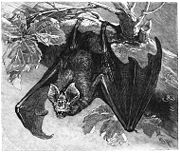 |
Rhinolophus ferrumequinum (Schreber, 1774) |
Roosts in caves and abandoned mines. | Scattered throughout, including Jeju Jeju-do Jeju-do is the only special autonomous province of South Korea, situated on and coterminous with the country's largest island. Jeju-do lies in the Korea Strait, southwest of Jeollanam-do Province, of which it was a part before it became a separate province in 1946... . |
|
| Family Vespertilionidae: Vesper bats | ||||
| Kobayashi's Bat Kobayashi's Bat Kobayashi's Bat is a species of bat. An adult Kobayashi's Bat has a body length of 6.0-6.3 cm, a tail length of 4.6-4.8 cm, and a wing length of 4.5-4.7 cm... |
Eptesicus koyabashii (Mori, 1928) |
West central Korea. |
|
|
| Northern Bat Northern Bat The Northern Bat is a species of bat. An adult Northern Bat has a body length of 4.9-6.6 cm, a tail of 3.2-5.1 cm, and a wing length of 4.1-5.1 cm. The species is found across Europe and Asia, from England to Hokkaidō and south to northern India.-References: 2006 IUCN Red List of Threatened... |
Eptesicus nilssonii (Keyserling Alexander Keyserling Alexander Friedrich Michael Lebrecht Nikolaus Arthur, Graf von Keyserling was a Baltic German geologist and paleontologist... et Blasius, 1839) |
Found in Gyeonggi, northwestern South Korea, and North Hamgyong, northeastern North Korea. |
|
|
| Serotine Bat Serotine bat The serotine bat Eptesicus serotinus is a fairly large European bat with quite large ears. It has a wingspan of around 370mm and often hunts in woodland. It sometimes roosts in buildings, hanging upside down, in small groups or individually...  |
Eptesicus serotinus (Schreber, 1774) |
Roosts in roofs and walls. | Most common in northwestern Korea. |
|
| Savi's Pipistrelle Savi's Pipistrelle Savi's Pipistrelle, Hypsugo savii is a species of vesper bat found across Eurasia. Its summer habitat is not known, but in winter it favors caves, old buildings, and rock crevices. The Hypsugo savii and the Pipistrellus kuhlii have a share of similarities... |
Hypsugo savii (Bonaparte, 1837) |
Roosts in caves. | Throughout. |
|
| Schreiber's Bat
|
Miniopterus schreibersi (Kuhl Heinrich Kuhl Heinrich Kuhl was a German naturalist and zoologist.Kuhl was born in Hanau. He became assistant to Coenraad Jacob Temminck at the Leiden museum. In 1817 he published a monograph on bats and in 1819 he published Conspectus psittacorum... , 1817) |
Grasslands and forests in summer; caves in winter. | Scattered throughout. |
|
| Little Tube-Nosed Bat Little Tube-Nosed Bat The Little Tube-Nosed Bat is a species of bat. An adult Little Tube-Nosed Bat has a body length of 4.0-4.6 cm, a tail length of 2.8-3.6 cm, and a wing length of 3.0-3.3 cm. The species is found across South and East Asia, from the Indian subcontinent to the Korean Peninsula.-External links:**... |
Murina aurata (Milne-Edwards Milne-Edwards Milne-Edwards may refer to:* Alphonse Milne-Edwards , French ornithologist and carcinologist. A son of Henri Milne-Edwards.* Henri Milne-Edwards , French zoologist.... , 1872) |
Unknown. |
|
|
| Greater Tube-Nosed Bat Greater Tube-Nosed Bat The Greater Tube-Nosed Bat is a species of bat. An adult Greater Tube-Nosed Bat has a body length of 4.2-5.7 cm, a tail length of 3.6-4.1 cm, and a wing length of 3.7-4.4 cm. The species is found in India, Mongolia, China, Korea, and Japan.-External links:*... |
Murina leucogaster (Milne-Edwards Milne-Edwards Milne-Edwards may refer to:* Alphonse Milne-Edwards , French ornithologist and carcinologist. A son of Henri Milne-Edwards.* Henri Milne-Edwards , French zoologist.... , 1872) |
Unknown. |
|
|
| Far Eastern Myotis Far Eastern Myotis The Far Eastern Myotis or Bombinus Bat, Myotis bombinus, is a species of mouse-eared bat found in East Asia. It is widespread but uncommon across the Korean Peninsula, and spends the winter hibernating in caves.... |
Myotis bombinus (Thomas Oldfield Thomas Oldfield Thomas FRS was a British zoologist.Thomas worked at the Natural History Museum on mammals, describing about 2,000 new species and sub-species for the first time. He was appointed to the Museum Secretary's office in 1876, transferring to the Zoological Department in 1878... , 1906) |
Hibernates in caves. | Throughout, including Jeju Jeju-do Jeju-do is the only special autonomous province of South Korea, situated on and coterminous with the country's largest island. Jeju-do lies in the Korea Strait, southwest of Jeollanam-do Province, of which it was a part before it became a separate province in 1946... . |
|
| Daubenton's Bat Daubenton's bat Daubenton's Bat, Myotis daubentonii, is a Eurasian bat with quite short ears. It ranges from Britain to Japan and is considered to be increasing its numbers in many areas.The name commemorates the French naturalist Louis-Jean-Marie Daubenton....  |
Myotis daubentonii (Kuhl Heinrich Kuhl Heinrich Kuhl was a German naturalist and zoologist.Kuhl was born in Hanau. He became assistant to Coenraad Jacob Temminck at the Leiden museum. In 1817 he published a monograph on bats and in 1819 he published Conspectus psittacorum... , 1817) |
Near water. | Throughout, including Jeju Jeju-do Jeju-do is the only special autonomous province of South Korea, situated on and coterminous with the country's largest island. Jeju-do lies in the Korea Strait, southwest of Jeollanam-do Province, of which it was a part before it became a separate province in 1946... . |
|
| Hodgson's Bat Hodgson's Bat Hodgson's Bat , also called the Copper-winged bat, is a species of bat. An adult Hodgson's Bat has a body length of 4.3-5.7 cm, a tail of 3.6-5.6 cm, and a wing length of 4.3-5.2 cm. Favoring mountain forests, it is found throughout Central, Southeast, and East Asia, from Afghanistan to the... |
Myotis formosus (Hodgson, 1835) |
Scattered throughout; not found on Jeju Jeju-do Jeju-do is the only special autonomous province of South Korea, situated on and coterminous with the country's largest island. Jeju-do lies in the Korea Strait, southwest of Jeollanam-do Province, of which it was a part before it became a separate province in 1946... . |
|
|
| Fraternal Myotis Fraternal Myotis The Fraternal Myotis is a species of bat. An adult Fraternal Myotis has a body length of about 5 cm, a tail of about 4.5 cm, and a wing span of about 3.8 cm. The species is found through Central and East Asia.-External links:*... |
Myotis frater (G.M. Allen Glover Morrill Allen Glover Morrill Allen was an American zoologist.He was born at Walpole, New Hampshire, the son of Reverend Nathaniel Glover Allen and Harriet Ann Allen, and studied at Harvard University,... , 1923) |
Forests. | Northern Korea. |
|
| Ikonnikov's Bat Ikonnikov's Bat Ikonnikov's Bat is a species of bat. An adult Ikonnikov's Bat has a body length of 4.2-5.1 cm, a tail of 3.1-4.0 cm, and a wing length of 3.3-3.6 cm. It is found in eastern Siberia, the Ussuri region, Sakhalin, Japan, and the Korean Peninsula.... |
Myotis ikonnikovi (Ognev, 1912) |
Scattered throughout, including Jeju Jeju-do Jeju-do is the only special autonomous province of South Korea, situated on and coterminous with the country's largest island. Jeju-do lies in the Korea Strait, southwest of Jeollanam-do Province, of which it was a part before it became a separate province in 1946... . |
|
|
| Big-Footed Myotis Big-Footed Myotis Eastern Long-fingered Bat, or Big-Footed Myotis is a species of bat. An adult Big-Footed Myotis has a body length of 4.1-4.8 cm, a tail of 3.1-4.9 cm, and a wing length of 3.7-4.2 cm.... |
Myotis macrodactylus (Temminck, 1840) |
Local throughout, including Jeju Jeju-do Jeju-do is the only special autonomous province of South Korea, situated on and coterminous with the country's largest island. Jeju-do lies in the Korea Strait, southwest of Jeollanam-do Province, of which it was a part before it became a separate province in 1946... . |
|
|
| Whiskered Bat Whiskered bat The whiskered bats Myotis mystacinus and related species, are small European bats with long fur. Although uncommon, M. mystacinus is often found around human habitation and around water; it is similar to Brandt's bat Myotis brandtii, from which it was distinguished as a separate species only in... 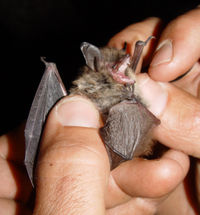 |
Myotis mystacinus (Kuhl, 1817) |
Forests. | Scattered throughout, including Jeju Jeju-do Jeju-do is the only special autonomous province of South Korea, situated on and coterminous with the country's largest island. Jeju-do lies in the Korea Strait, southwest of Jeollanam-do Province, of which it was a part before it became a separate province in 1946... and Ulleungdo Ulleungdo Ulleungdo is a South Korean island in the Sea of Japan . Formerly known as Dagelet to the Europeans, Ulleungdo is about 120 km east of the Korean Peninsula... . |
|
| Birdlike Noctule Birdlike Noctule The Birdlike Noctule is a species of bat. An adult Birdlike Noctule has a body length of 7.1-9.5 cm, a tail of 5.5-6.4 cm, and a wing length of 5.8-5.95 cm. It nests in the holes in old trees and buildings, and sometimes in mineshafts... |
Nyctalus aviator (Thomas Oldfield Thomas Oldfield Thomas FRS was a British zoologist.Thomas worked at the Natural History Museum on mammals, describing about 2,000 new species and sub-species for the first time. He was appointed to the Museum Secretary's office in 1876, transferring to the Zoological Department in 1878... , 1911) |
Scattered throughout. |
|
|
| Java Pipistrelle Java Pipistrelle The Java Pipistrelle, Pipistrellus javanicus, is a species of pipistrelle bat found in South and Southeast Asia, including Afghanistan; Bangladesh; Brunei; Cambodia; China; India; Indonesia; Laos; Malaysia; Myanmar; Nepal; Pakistan; Philippines; Singapore; Thailand and Vietnam. It favors human... |
Pipistrellus javanicus (Gray, 1838) |
Scattered throughout. |
|
|
| Brown Long-Eared Bat Brown long-eared bat The brown long-eared bat or common long-eared bat is a fairly large European bat. It has distinctive ears, long and with a distinctive fold...  |
Plecotus auritus (Linnaeus, 1758) |
High mountains. | The Taebaek Mountains Taebaek Mountains The Taebaek Mountains are a mountain range in both North Korea and South Korea. They form the main ridge of the Korean peninsula.-Geography:... and the Paektusan area in northern North Korea. |
|
Parti-colored Bat
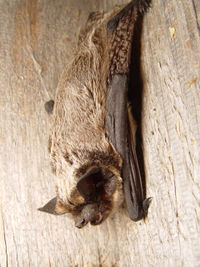 |
Vespertilio murinus (Linnaeus, 1758) |
High forests and grasslands in the summer. | North Hamgyong, North Korea. |
|
| Asian Parti-colored Bat Asian Parti-colored Bat The Asian Parti-colored Bat is a species of bat. An adult Asian Parti-colored Bat has a body length of 6-7 cm, a tail of 4.3-4.5 cm, and a wing length of 5 cm. The Asian Parti-colored Bats are distributed across East Asia, from Taiwan through eastern China and Siberia to the Korean Peninsula and... |
Vespertilio superans (Thomas Oldfield Thomas Oldfield Thomas FRS was a British zoologist.Thomas worked at the Natural History Museum on mammals, describing about 2,000 new species and sub-species for the first time. He was appointed to the Museum Secretary's office in 1876, transferring to the Zoological Department in 1878... , 1899) |
West central Korea. |
|
|
Order Lagomorpha: Lagomorphs
| Common name (Korean name) |
Species (Authority) |
Preferred habitat | Range | Status |
|---|---|---|---|---|
| Family Leporidae Leporidae Leporids are the approximately 50 species of rabbits and hares which form the family Leporidae. The leporids, together with the pikas, constitute the mammalian order Lagomorpha. Leporids differ from pikas in having short furry tails, and elongated ears and hind legs... : Leporids |
||||
| Korean Hare Korean Hare The Korean Hare is a species of hare found in Korea and northeastern China. An adult Korean Hare weighs 2.1-2.6 kilograms, and has a body length of 45-54 centimeters. The tail is typically 2-5 cm in length, and the ears are 7.6-8.3 cm long. The Korean Hare inhabits diverse habitats... |
Lepus coreanus (Thomas Oldfield Thomas Oldfield Thomas FRS was a British zoologist.Thomas worked at the Natural History Museum on mammals, describing about 2,000 new species and sub-species for the first time. He was appointed to the Museum Secretary's office in 1876, transferring to the Zoological Department in 1878... , 1892) |
Widespread at low altitudes. | Throughout mainland. |
|
| Manchurian Hare Manchurian Hare The Manchurian Hare is a species of hare found in northeastern China, the Amur River basin, and in the higher mountains of northern Korea. The adult Manchurian Hare weighs about 2 kilograms, and has a body length of , in addition to a tail of . The ears are typically 7.5–10.4 centimeters in length... |
Lepus mandschuricus (Radde, 1861) |
High rocky forests. | Northern Korea. |
|
| Family Ochotonidae: Pikas | ||||
| Northern Pika Northern Pika The Northern Pika, Ochotona hyperborea, is a species of pika found across northern Asia, from the Ural Mountains to northern Japan and south through Mongolia, Manchuria, and northern Korea. An adult Northern Pika has a body length of 12.7-18.6 centimeters, and a tail of .5-1.2 centimeters... |
Ochotona hyperborea (Pallas, 1811) |
Alpine meadows, 1000-2500 m. | Northern Korea. |
|
Order Rodentia: Rodents
| Common name (Korean name) |
Species (Authority) |
Preferred habitat | Range | Status |
|---|---|---|---|---|
| Family Muridae Muridae Muridae is the largest family of mammals. It contains over 600 species found naturally throughout Eurasia, Africa, and Australia. They have been introduced worldwide. The group includes true mice and rats, gerbils, and relatives.... : Murids |
||||
| Striped Field Mouse Striped Field Mouse The Striped Field Mouse is a rodent in the family Muridae. The range of this species stretches from Eastern Europe to Japan, including Taiwan and Siberia....  |
Apodemus agrarius (Pallas, 1771) |
Widespread. | Throughout, including Jeju Jeju-do Jeju-do is the only special autonomous province of South Korea, situated on and coterminous with the country's largest island. Jeju-do lies in the Korea Strait, southwest of Jeollanam-do Province, of which it was a part before it became a separate province in 1946... . |
|
| Jeju Striped Field Mouse Jeju Striped Field Mouse The Jeju Striped Field Mouse, or Apodemus chejuensis, is a field mouse found only on Jejudo, an island in the northern East China Sea off the southwestern coast of South Korea. It was originally described in 1965 as a subspecies of Apodemus agrarius... |
Apodemus chejuensis (Jones et Johnson, 1965) |
Widespread. | Found only on Jeju Jeju-do Jeju-do is the only special autonomous province of South Korea, situated on and coterminous with the country's largest island. Jeju-do lies in the Korea Strait, southwest of Jeollanam-do Province, of which it was a part before it became a separate province in 1946... . |
|
| Korean Field Mouse Korean field mouse The Korean field mouse , also known as the Korean wood mouse, is a species of mouse. It is distributed across Northeastern Asia, including the Russian Far East, northern China, the Korean Peninsula, Sakhalin, and Hokkaidō. It is not found on the Korean island of Jeju... |
Apodemus peninsulae (Thomas Oldfield Thomas Oldfield Thomas FRS was a British zoologist.Thomas worked at the Natural History Museum on mammals, describing about 2,000 new species and sub-species for the first time. He was appointed to the Museum Secretary's office in 1876, transferring to the Zoological Department in 1878... , 1907) |
Forest verges and brushland. | Throughout mainland. |
|
Harvest Mouse
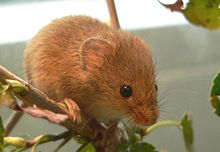 |
Micromys minutus (Pallas, 1771) |
Low grasslands and fields. | Throughout; not found on Ulleungdo Ulleungdo Ulleungdo is a South Korean island in the Sea of Japan . Formerly known as Dagelet to the Europeans, Ulleungdo is about 120 km east of the Korean Peninsula... . |
|
| House Mouse House mouse The house mouse is a small rodent, a mouse, one of the most numerous species of the genus Mus.As a wild animal the house mouse mainly lives associated with humans, causing damage to crops and stored food....  |
Mus musculus (Linnaeus, 1758) |
Human dwellings. | Throughout. |
|
Norway Rat
 |
Rattus norvegicus (Berkenhout, 1769) |
Urban and cultivated areas. | Throughout. |
|
| Black Rat Black Rat The black rat is a common long-tailed rodent of the genus Rattus in the subfamily Murinae . The species originated in tropical Asia and spread through the Near East in Roman times before reaching Europe by the 1st century and spreading with Europeans across the world.-Taxonomy:The black rat was...  |
Rattus rattus (Linnaeus, 1758) |
Urban areas. | Central and southern Korea. |
|
| Family Cricetidae Cricetidae The Cricetidae are a family of rodents in the large and complex superfamily Muroidea. It includes true hamsters, voles, lemmings, and New World rats and mice... : Cricetids |
||||
| Northern Red-Backed Vole Northern Red-backed Vole The northern red-backed vole, Myodes rutilus, is a small slender vole found in Alaska, northern Canada, Scandinavia and northern Russia.-Description:... |
Myodes rutilus (Pallas, 1779) |
High, dense mixed forest. | Far northeastern Korea. |
|
| Grey Red-Backed Vole Grey Red-Backed Vole The Grey Red-backed Vole is a species of vole. An adult Grey Red-backed Vole weighs 20-50 grams, and has a body length of 110-142 millimeters, with a tail of 39–55 mm in length. This species ranges across northern Eurasia, including northern China, the northern Korean Peninsula, and... |
Myodes rufocanus (Sundevall, 1846) |
Boreal forest. | Northern Korea. |
|
| Chinese Striped Hamster Chinese Striped Hamster The Chinese striped hamster , also known as the striped dwarf hamster, is a species of hamster. It is distributed across Northern Asia, from southern Siberia through Mongolia and northeastern China to northern North Korea. An adult Chinese striped hamster weighs 16.7-31.0g, and has a body length...  |
Cricetulus barabensis (Pallas, 1773) |
Fields. | Sinuiju Sinuiju Sinŭiju is a city in North Korea, neighboring with Dandong City, China via international border and is the capital of North P'yŏngan Province... and Cholsan Cholsan Cholsan is a kun, or county, in North Pyongan province, North Korea. It occupies the Cholsan Peninsula, which juts into the Yellow Sea. Cholsan borders Yomju and Tongrim to the north, and is bounded on all other sides by water.... , North Korea. |
|
| Royal Vole Royal Vole The Royal Vole , also called the Korean Red-backed Vole is a species of vole found in the Korean Peninsula and the Changbai Mountains along the Chinese-Korean border. An adult Royal Vole weighs 20-40 grams and has a body length of 75-127 mm. The tail is 33-55 millimeters in... |
Eothenomys regulus (Thomas Oldfield Thomas Oldfield Thomas FRS was a British zoologist.Thomas worked at the Natural History Museum on mammals, describing about 2,000 new species and sub-species for the first time. He was appointed to the Museum Secretary's office in 1876, transferring to the Zoological Department in 1878... , 1907) |
Widespread; avoids deep forests. | Southern, central and northwestern Korea. |
|
| Mandarin Vole Mandarin Vole The Mandarin Vole is a species of vole found in central China as well as the southern and central Korean Peninsula. An adult Mandarin Vole is typically of about 115 millimeters in length, in addition to about 28 mm of tail... |
Lasiopodomys mandarinus (Milne-Edwards Milne-Edwards Milne-Edwards may refer to:* Alphonse Milne-Edwards , French ornithologist and carcinologist. A son of Henri Milne-Edwards.* Henri Milne-Edwards , French zoologist.... , 1871) |
Grassy wetlands. | Southwestern Korea. |
|
| Reed Vole Reed Vole The Reed Vole is a species of vole. It is found in northern and central Eurasia, including northern China and the Korean Peninsula. The species is somewhat larger and longer-tailed than most other voles. An adult Reed Vole has a body 12-18 centimeters long, and a tail of 4.7-5.7... |
Microtus fortis (Buchner, 1889) |
High fields and forest verges. | Western and northern Korea. |
|
| Muskrat Muskrat The muskrat , the only species in genus Ondatra, is a medium-sized semi-aquatic rodent native to North America, and introduced in parts of Europe, Asia, and South America. The muskrat is found in wetlands and is a very successful animal over a wide range of climates and habitats...  |
Ondatra zibethicus (Linnaeus, 1766) |
Marshes and lakes. | Tumen River Tumen River The Tumen River is a 521 km-long river that serves as part of the boundary between China, North Korea, and Russia, rising in Mount Baekdu and flowing into the Sea of Japan.... basin, North Korea. |
|
| Greater Long-Tailed Hamster Greater Long-tailed Hamster The Greater Long-tailed Hamster is a major crop-eating rodent that resides in Northern China. It is the only member of the genus Tscherskia. Some authorities maintain that the 15th gua of the Yi Jing refers repeatedly to this animal... |
Tscherskia triton (de Winton William Edward de Winton William Edward de Winton was a British zoologist. He traveled widely, and discovered a number of previously undescribed cricetid species. His East Africa photo collection, from the late 1890s, is kept at the London Natural History Museum.-Notes:... , 1899) |
Widespread. | Throughout, including Jeju. |
|
| Family Myocastoridae: the Coypu | ||||
| Coypu Coypu The coypu , , also known as the river rat, and nutria, is a large, herbivorous, semiaquatic rodent and the only member of the family Myocastoridae. Originally native to subtropical and temperate South America, it has since been introduced to North America, Europe, Asia, and Africa, primarily by... or Nutria  |
Myocastor coypus (Molina, 1782) |
Wetlands. | South Korea's Yeongnam Yeongnam Yeongnam is the name of a region that coincides with the former Gyeongsang Province in what is now South Korea.... region. (Introduced for farming in 1990s) |
|
| Family Sciuridae: Squirrels | ||||
| Siberian Flying Squirrel Siberian Flying Squirrel The Siberian Flying Squirrel is an Old World flying squirrel with a range from the Baltic Sea in the west to the Pacific coast in the east. It is the only species of flying squirrel found in Europe... 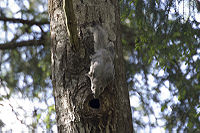 |
Pteromys volans (Linnaeus, 1758) |
Boreal forest. | Far northeast and Taebaek Mountains Taebaek Mountains The Taebaek Mountains are a mountain range in both North Korea and South Korea. They form the main ridge of the Korean peninsula.-Geography:... . |
|
| Red Squirrel Red Squirrel The red squirrel or Eurasian red squirrel is a species of tree squirrel in the genus Sciurus common throughout Eurasia... 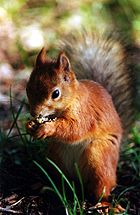 |
Sciurus vulgaris (Linnaeus, 1758) |
Forests. | Throughout mainland. |
|
| Siberian Chipmunk Siberian Chipmunk The Siberian chipmunk or Common Chipmunk is a chipmunk which occurs across northern Asia from central Russia to China, Korea, and Hokkaidō in northern Japan. The only chipmunk found outside North America, it is classed either as the only living member of the genus Eutamias, or a member of a genus...  |
Tamias sibiricus (Laxmann, 1769) |
Forests. | Inland throughout. |
|
| Family Dipodidae Dipodidae The Dipodidae, or dipodids, are a family of rodents found across the northern hemisphere. This family includes over 50 species among the 16 genera.... : Jumping mice |
||||
| Long-Tailed Birch Mouse
|
Sicista caudata (Thomas Oldfield Thomas Oldfield Thomas FRS was a British zoologist.Thomas worked at the Natural History Museum on mammals, describing about 2,000 new species and sub-species for the first time. He was appointed to the Museum Secretary's office in 1876, transferring to the Zoological Department in 1878... , 1907) |
Riparian zones and wetlands. | Northeastern Korea. |
|

